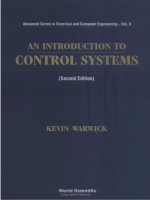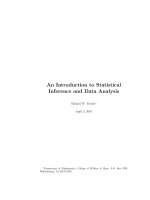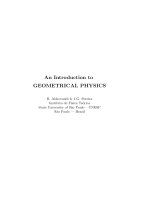- Trang chủ >>
- Khoa Học Tự Nhiên >>
- Vật lý
an introduction to stochastic processes in physics - d. lemons
Bạn đang xem bản rút gọn của tài liệu. Xem và tải ngay bản đầy đủ của tài liệu tại đây (407.27 KB, 124 trang )
An Introduction to Stochastic
Processes in PhysicsAn Introduction to
Stochastic Processes
in Physics
Containing “On the Theory of Brownian
Motion” by Paul Langevin, translated by
Anthony Gythiel
DON S. LEMONS
THE JOHNS HOPKINS UNIVERSITY PRESS
BALTIMORE AND LONDON
Copyright
c
2002 The Johns Hopkins University Press
All rights reserved. Published 2002
Printed in the United States of America on acid-free paper
987654321
The Johns Hopkins University Press
2715 North Charles Street
Baltimore, Maryland 21218-4363
www.press.jhu.edu
Library of Congress Cataloging-in-Publication Data
Lemons, Don S. (Don Stephen), 1949–
An introduction to stochastic processes in physics / by Don S. Lemons
p. cm.
Includes bibliographical references and index.
ISBN 0-8018-6866-1 (alk. paper) – ISBN 0-8018-6867-X (pbk. : alk. paper)
1. Stochastic processes. 2. Mathematical physics. I. Langevin, Paul, 1872–1946. II. Title.
QC20.7.S8 L45 2001
530.15
923–dc21 2001046459
A catalog record for this book is available from the British Library
ForAllison, Nathan, and Micah
Preface and Acknowledgments xi
Chapter 1 – Random Variables 1
1.1 Random and Sure Variables 1
1.2 Assigning Probabilities 2
1.3 The Meaning of Independence 4
Problems: 1.1. Coin Flipping, 1.2. Independent Failure Modes 5
Chapter 2 – Expected Values 7
2.1 Moments 7
2.2 Mean Sum Theorem 9
2.3 Variance Sum Theorem 10
2.4 Combining Measurements 12
Problems: 2.1. Dice Parameters, 2.2. Perfect Linear Correlation,
2.3. Resistors in Series, 2.4. Density Fluctuations
14
Chapter 3 – Random Steps 17
3.1 Brownian Motion Described 17
3.2 Brownian Motion Modeled 18
3.3 Critique and Prospect 19
Problems: 3.1. Two-Dimensional Random Walk, 3.2. Random Walk
with Hesitation, 3.3. Multistep Walk, 3.4. Autocorrelation,
3.5. Frequency of Heads
20
Chapter 4 – Continuous Random Variables 23
4.1 Probability Densities 23
4.2 Uniform, Normal, and Cauchy Densities 24
4.3 Moment-Generating Functions 27
Problems: 4.1. Single-Slit Diffraction, 4.2. Moments of a Normal,
4.3. Exponential Random Variable, 4.4. Poisson Random Variable
29
Chapter 5 – Normal Variable Theorems 33
5.1 Normal Linear Transform Theorem 33
5.2 Normal Sum Theorem 34
5.3 Jointly Normal Variables 35
viii CONTENTS
5.4 Central Limit Theorem 36
Problems: 5.1. Uniform Linear Transform, 5.2. Adding Uniform
Variables, 5.3. Dependent Normals
39
Chapter 6 – Einstein’s Brownian Motion 41
6.1 Sure Processes 41
6.2 Wiener Process 43
6.3 Brownian Motion Revisited 45
6.4 Monte Carlo Simulation 46
6.5 Diffusion Equation 48
Problems: 6.1. Autocorrelated Process, 6.2. Concentration Pulse,
6.3. Brownian Motion with Drift, 6.4. Brownian Motion in a
Plane
49
Chapter 7 – Ornstein-Uhlenbeck Processes 53
7.1 Langevin Equation 53
7.2 Solving the Langevin Equation 54
7.3 Simulating the O-U Process 57
7.4 Fluctuation-Dissipation Theorem 59
7.5 Johnson Noise 60
Problems: 7.1. Terminal Speed, 7.2. RL Circuit 62
Chapter 8 – Langevin’s Brownian Motion 63
8.1 Integrating the O-U Process 63
8.2 Simulating Langevin’s Brownian Motion 66
8.3 Smoluchowski Approximation 68
8.4 Example: Brownian Projectile 69
Problems: 8.1. Derivation, 8.2. X-V Correlation, 8.3. Range Variation 72
Chapter 9 – Other Physical Processes 75
9.1 Stochastic Damped Harmonic Oscillator 75
9.2 Stochastic Cyclotron Motion 80
Problems: 9.1. Smoluchowski Oscillator, 9.2. Critical Damping,
9.3. Oscillator Energy, 9.4. O-U Process Limit, 9.5. Statistical
Independence
83
Chapter 10 – Fluctuations without Dissipation 85
10.1 Effusion 85
10.2 Elastic Scattering 88
Problems: 10.1.Two-LevelAtoms, 10.2. Cross-Field Diffusion,10.3.Mean
Square Displacement
94
CONTENTS ix
Appendix A: “On the Theory of Brownian Motion,” by Paul
Langevin, translated by Anthony Gythiel 97
Appendix B: Kinetic Equations 101
Answers to Problems 103
References 107
Index 109
Preface and Acknowledgments
Physicists have abandoned determinism as a fundamental description of real-
ity. The most precise physical laws we have are quantum mechanical, and the
principle of quantum uncertainty limits our ability to predict, with arbitrary
precision, the future state of even the simplest imaginable system. However,
scientists began developing probabilistic, that is, stochastic, models of natu-
ral phenomena long before quantum mechanics was discovered in the 1920s.
Classical uncertainty preceded quantum uncertainty because, unlike the latter,
the former is rooted in easily recognized human conditions. We are too small
and the universe too large and too interrelated for thoroughly deterministic
thinking.
Forwhatever reason—fundamental physical indeterminism, human finitude,
or both—there is much we don’t know. And what we do know is tinged with
uncertainty. Baseballsand hydrogenatoms behave, toa greateror lesserdegree,
unpredictably. Uncertainties attend their initial conditions and their dynamical
evolution. Thisalso istrue ofevery artificial device, natural system,and physics
experiment.
Nevertheless, physics and engineering curriculums routinely invoke precise
initial conditionsand the existence of deterministicphysical laws thatturn these
conditions into equally precise predictions. Students spend many hours in in-
troductory courses solving Newton’s laws of motion for the time evolution of
projectiles, oscillators, circuits, and charged particles before they encounter
probabilistic concepts in their study of quantum phenomena. Of course, deter-
ministic models are useful, and, possibly, the double presumption of physical
determinism and superhuman knowledge simplifies the learning process. But
uncertainties are always there. Too often these uncertainties are ignored and
their study delayed or omitted altogether.
An Introduction to Stochastic Processes in Physics revisits elementary and
foundational problems in classical physics and reformulates them in the lan-
guage of random variables. Well-characterized random variables quantify un-
certainty and tell us what can be known of the unknown. A random variable
is defined by the variety of numbers it can assume and the probability with
which each number is assumed. The number of dots showing face up on a
die is a random variable. A die can assume an integer value 1 through 6, and,
if unbiased and honestly rolled, it is reasonable to suppose that any particular
side will come up one time out of six in the long run, that is, with a probability
of 1/6.
xii PREFACE AND ACKNOWLEDGMENTS
This work builds directly upon early twentieth-century explanations of the
“peculiar character in the motions of the particles of pollen in water,” as de-
scribed in the early nineteenth centuryby the British cleric and biologist Robert
Brown. Paul Langevin, in 1908, was the first to apply Newton’s second law to
a“Brownian particle,” on which the total force included a random component.
Albert Einsteinhad, three yearsearlier thanLangevin, quantifiedBrownian mo-
tion withdifferent methods,but weadopt Langevin’s approach becauseit builds
mostdirectly onNewtonian dynamicsandon conceptsfamiliarfrom elementary
physics. Indeed, Langevin claimed his method was “infinitely more simple”
than Einstein’s. In 1943 Subrahmanyan Chandrasekhar was able to solve a
number of important dynamical problems in terms of probabilistically defined
random variables that evolved according to Langevin’s version of F = ma .
However, his famous review article, “Stochastic Problems in Physics and As-
tronomy” (Chandrasekhar 1943) is too advanced for students approaching the
subject for the first time.
This book is designed for those students. The theory is developed in steps,
new methods are tried on old problems, and the range of applications extends
only to the dynamics of those systems that, in the deterministic limit, are de-
scribed by linear differential equations. A minimal set of required mathe-
matical concepts is developed: statistical independence, expected values, the
algebra ofnormalvariables, thecentral limittheorem, andWiener andOrnstein-
Uhlenbeck processes. Problems append each chapter. I wanted the book to be
one I could give my own students and say, “Here, study this book. Then we
will do some interesting research.”
Writing a book is a lonely enterprise. For this reason I am especially grate-
ful to those who aided and supported me throughout the process. Ten years
ago Rick Shanahan introduced me to both the concept of and literature on
stochastic processes and so saved me from foolishly trying to reinvent the field.
Subsequently, I learned much of what I know about stochastic processes from
Daniel Gillespie’s excellent book (Gillespie 1992). Until his recent, untimely
death, Michael Jones of Los Alamos National Laboratory was a valued part-
ner in exploring new applications of stochastic processes. Memory eternal,
Mike! A sabbatical leave from Bethel College allowed me to concentrate on
writing during the 1999–2000 academic year. Brian Albright, Bill Daughton,
Chris Graber, Bob Harrington, Ed Staneck, and Don Quiring made valuable
comments on various parts of the typescript. Willis Overholt helped with the
figures. Moregeneral encouragementcame fromReubenHersh,Arnold Wedel,
and Anthony Gythiel. I am grateful for all of these friends.
Processes in Physics
1
Random Variables
1.1 Random and Sure Variables
A quantity that, under given conditions, can assume different values is a
random variable.Itmatters not whether the random variation is intrinsic and
unavoidable or an artifact of our ignorance. Physicists can sometimes ignore
the randomness of variables. Social scientists seldom have this luxury.
The total number of “heads” in ten coin flips is a random variable. So also
is the range of a projectile. Fire a rubber ball through a hard plastic tube with a
smallquantityofhairsprayforpropellant. Evenwhenyouarecarefultokeepthe
tube ataconstant elevation, toinject thesamequantityofpropellant, and tokeep
all conditions constant, the projectile landsat noticeably different places insev-
eraltrials. Onecan imagineanumberofcauses ofthisvariation: differentinitial
orientations of a not-exactly-spherical ball, slightly variable amounts of propel-
lant, and breeziness at the topof the trajectory. In this as wellas in similar cases
wedistinguish betweensystematicerror andrandomvariation.Theformercan,
in principle, be understood and quantified and thereby controlled or eliminated.
Truly random sources of variation cannot be associated with determinate phys-
ical causes and are often too small to be directly observed. Yet, unnoticeably
small and unknown random influences can have noticeably large effects.
Arandom variable is conceptuallydistinct from a certain or sure variable.A
sure variable is, by definition, exactly determined by given conditions. Newton
expressed his second law of motion in terms of sure variables. Discussions of
sure variables are necessarily cast in terms of concepts from the ivory tower of
physics: perfect vacuums, frictionless pulleys, point charges, and exact initial
conditions. The distance an object falls from rest, in a perfect vacuum, when
constantly accelerating for a definite period of time is a sure variable.
Justas itishelpfulto distinguishnotationallybetweenscalars andvectors, itis
also helpful to distinguish notationally between random and sure variables. As
is customary, we denote random variables by uppercase letters near the end of
the alphabet, for example, V,W, X,Y,andZ,while we denotesure variables by
lowercase letters, for example, a, b, c, x,andy.The time evolution of a random
variable iscalleda randomor stochasticprocess.Thus X(t) denotesastochastic
process. The time evolution of a sure variable is called a deterministic process
and could be denoted by x(t).Sure variables and deterministic processes are
2 RANDOM VARIABLES
familiar mathematical objects. Yet, in a sense, they are idealizations of random
variables and processes.
Modeling a physical process with sure instead of random variables involves
an assumption—sometimes an unexamined assumption. How do we know,
for instance, that the time evolution of a moon of Jupiter is a deterministic
process while the time evolution of a small grain of pollen suspended in water
is a random process? What about the phase of a harmonic oscillator or the
charge on a capacitor? Are these sure or random variables? How do we choose
between these two modeling assumptions?
That all physical variables and processes are essentially random is the more
general of the two viewpoints. After all, a sure variable can be considered
aspecial kind of random variable—one whose range of random variation is
zero. Thus, we adopt as a working hypothesis that all physical variables and
processes are random ones. The details of a theory of random variables and
processes will tell us under what special conditions sure variables and deter-
ministic processes are good approximations. We develop such a theory in the
chapters that follow.
1.2 Assigning Probabilities
Arandom variable X is completely specified by the range of values x it can
assume and the probability P(x) with which each is assumed. That is to say,
the probabilities P(x) that X = x for all possible values of x tell us everything
there is to know about the random variable X. But how do we assign a number
to “the probability that X = x”? There are at least two distinct answers to
this question—two interpretations of the word probability and, consequently,
two interpretations of the phrase random variable. Both interpretations have
been with us since around 1660, when the fundamental laws of mathematical
probability were first discovered (Hacking 1975).
Consider a coin toss and associate a random variable X with each possible
outcome. For instance, when the coin lands heads up, assign X = 1, and when
the coin lands tails up, X = 0. To determine the probability P(1) of a heads-up
outcome, onecouldflip thecoin many timesunderidentical conditionsandform
the ratio of the number of heads to the total number of coin flips. Call that ratio
f (1).According to the statistical or frequency interpretation of probability,
the ratio f (1) approaches the probability P(1) in the limit of an indefinitely
large number of flips. One virtue of the frequency interpretation is that it
suggests a direct way of measuring or, at least, estimating the probability of a
random outcome. The Englishstatistician J. E.Kerrichso estimated P(1) while
interned in Denmark during World War II (Kerrich 1946). He flipped a coin
10,000timesandfoundthat headslandeduppermostin5067“spins.” Therefore,
P(1) ≈ f (1) = 0.5067—at least for Kerrich’s coin and method of flipping.
ASSIGNING PROBABILITIES 3
Figure 1.1. Frequency of heads, f (1),versusnumber of flips, n.Replotted, from
Kerrich 1946.
Kerrich’s was not the first heroic frequency measurement. In 1850 the Swiss
astronomer Wolf rolled one white and one red die 20,000 times, kept track
of the results, and determined the frequency of each outcome (Bulmer 1967).
Also, a certain nineteenth-century English biologist Weldon also rolled twelve
dice 26,306 times and recorded the number of 5s and 6s (Fry 1928).
That actual events can’t be repeated ad infinitum doesn’t invalidate the fre-
quency interpretationof probability any more thanthe impossibility of aperfect
vacuum invalidates the law of freefall. Both are idealizations that make a claim
about what happens in a series of experiments as an unattainable condition is
more and more closely approached. In particular, the frequency interpretation
claims that fluctuations in f (1) around P(1) become smaller and smaller as the
number of coin flips becomes larger and larger. Because Kerrich’s data, in fact,
has this feature (see figure 1.1), his coin flip can be considered a random event
with its defining probabilities, P(1) and P(0),equal to the limiting values of
f (1) and f (0).
An alternative method of determining P(1) is to inspect the coin and, if
you can find no reason why one side should be favored over the other, simply
assert that P(1) = P(0) = 1/2. This method of assigning probabilities is
typicalof theso-calleddegreeof belief orinductive interpretationofprobability.
According to this view, a probability quantifies the truth-value of a proposition.
In physics we are primarily concerned with propositions of the form X =
x.Inassigning an inductive probability P(X = x),orsimply P(x),tothe
proposition X = x,wemake a statement about the degree to which X = x is
believable. Of course, if they are to be useful, inductive probabilities should
not be assigned haphazardly but rather should reflect the available evidence
and change when that evidence changes. In this account probability theory
4 RANDOM VARIABLES
extends deductive logic to cases involving partial implication—thus the name
inductive probability.Observe that inductive probabilities can be assigned to
any outcome, whether repeatable or not.
The principle ofindifference,devised by PierreSimon Laplace (1749–1827),
is one procedure for assigning inductive probabilities. According to this prin-
ciple, which was invoked above in asserting that P(1) = P(0) = 1/2, one
should assign equal probabilities to different outcomes if there is no reason to
favor one outcome over any other. Thus, given a seemingly unbiased six-sided
die, the inductive probability of any one side coming up is 1/6. The principle
of equal a priori probability,that a dynamical system in equilibrium has an
equal probability of occupying each of its allowed states, is simply Laplace’s
principle of indifference in the context of statistical mechanics. The principle
of maximum entropy is another procedure for assigning inductive probabilities.
While agood method forassigning inductive probabilitiesisn’t always obvious,
this is morea technical problemto be overcome than alimitation of the concept.
That the laws of probability are the same under both of these interpretations
explains, in part, why the practice of probabilistic physics is much less contro-
versial than its interpretation, just as the practice of quantum physics is much
less controversial than its interpretation. For this reason one might be tempted
to embrace a mathematical agnosticism and be concerned only with the rules
that probabilities obey and not at all with their meaning. But a scientist or
engineer needs some interpretation of probability, if only to know when and to
what the theory applies.
Thebest interpretationofprobability isstillanopenquestion. Butprobability
as quantifying a degree of belief seems the most inclusive of the possibilities.
After all, one’s degree of belief could reflect an in-principle indeterminism or
an ignorance born of human finitude or both. Frequency data is not required
for assigning probabilities, but when available it could and should inform one’s
degree of belief. Nevertheless, the particular random variables we study also
make sense when their associated probabilities are interpreted strictly as limits
of frequencies.
1.3 The Meaning of Independence
Suppose twounbiaseddice are rolled. If the fact thatone shows a“5” doesn’t
change theprobability that theother also shows a “5,” the two outcomes aresaid
to be statistically independent,orsimply independent.Whenthe two outcomes
are independent and the dice unbiased, the probability that both dice will show
a“5” is the product (1/6)(1/6) = 1/36. While statistical independence is the
rule among dicing outcomes, the random variables natural to classical physics
are often statistically dependent. For instance, one usually expects the location
X of a particle to depend in some way upon its velocity V.
PROBLEMS 5
Let’s formalize the concept of statistical independence. If realization of
the outcome X = x does not change the probability P(y) that outcome Y =
y obtains and vice-versa, the outcomes X = x and Y = y are statistically
independent and the probability that they occur jointly P(x&y) is the product
P(x)P(y),thatis,
P(x&y) = P(x)P(y). (1.3.1)
When condition (1.3.1) obtains for all possible realizations x and y,the
random variables X and Y are said to be statistically independent. If, on the
other hand, the realization X = x does change the probability P(y) that Y = y
or vice-versa, then
P(x&y) = P(x)P(y)(1.3.2)
and the random variables X and Y are statistically dependent.
The distinction between independent anddependentrandom variables is cru-
cial. In the next chapter we construct a numerical measure of statistical depen-
dence. Andinsubsequent chapterswewill, onseveral occasions,exploitspecial
sets of explicitly independent and dependent random variables.
Problems
1.1. Coin Flipping. Produce a graph of the frequency of heads f (1) versus
the number of coin flips n. Use data obtained from
a. flipping a coin 100 times,
b. pooling your coin flip data with that of others, or
c. numerically accessing an appropriate random number generator 10,000
times.
Do fluctuations in f (1) obtained via method a, b, and c diminish, as do those
in figure 1.1, as more data is obtained?
1.2 Independent Failure Modes. Asystemconsists of n separate com-
ponents, each one of which fails independently of the others with probability
P
i
where i = 1 n.Since each component must either fail or not fail, the
probability that the ith component does not fail is 1 − P
i
.
a. Suppose the components are connected in parallel so that the failure
of all the components is necessary to cause the system to fail. What
is the probability the system fails? What is the probability the system
functions?
b. Suppose the components are connected in series so that the failure of
any one component causes the system to fail. What is the probability
the system fails? (Hint: First, find the probability that all components
function.)
Expected Values
2.1 Moments
The expected value of a random variable X is a function that turns the prob-
abilities P(x) into a sure variable called the mean of X.Themean is the one
number that best characterizes the possible values of a random variable. We
denote the mean of X variously by mean{X} and X and define it by
X=
i
x
i
P(x
i
)(2.1.1)
where the sum is over all possible realizations x
i
of X.Thus, the mean number
of dotsshowing onanunbiaseddieis (1+2+3+4+5+6)/6 = 3.5. The square
of a random variable is also a random variable. If the possible realizations of
X are the numbers 1, 2, 3, 4, 5, and 6, then their squares, 1, 4, 9, 16, 25, and
36, are the possible realizations of X
2
.Infact, any algebraic function f (x)
of a random variable X is also a random variable. The expected value of the
random variable f (X) is denoted by f (x) and defined by
f (x)=
i
f (x
i
)P(x
i
). (2.1.2)
The mean X parameterizes the random variable X,butsoalso do all the
moments X
n
(n = 0, 1, 2, ) and moments about the mean (X −X)
n
.
The operation by which a random variable X is turned into one of its moments
is one way ofaskingX to reveal its properties, or parameters.Among the
moments about the mean,
(x −X)
0
=1
=
i
P(x)
= 1 (2.1.3)
simply recovers the fact that probabilities are normalized. And
(X −X)
1
=
i
(x
1
−X)P(x
i
)
8 EXPECTED VALUES
=
i
x
i
P(x
i
) −X
i
P(x
i
)
=X−X1
= 0 (2.1.4)
follows from normalization (2.1.3) and the definition of the mean (2.1.1).
Higher order moments (with n ≥ 2)describe other properties of X.For
instance, the second moment about the mean or the variance of X,denoted by
var{X} and defined by
var{X}=(X −X)
2
,(2.1.5)
quantifies the variability, or mean squared deviation, of X from its mean X.
The linearity of the expected value operator (see section 2.2) ensures that
(2.1.5) reduces to
var{X}=X
2
− 2XX+X
2
=X
2
−2X
2
+X
2
=X
2
−X
2
. (2.1.6)
The mean and variance are sometimes denoted by the Greek letters µ and σ
2
,
respectively, and
√
σ
2
= σ is called the standard deviation of X.Thethird
moment about the mean enters into the definition of skewness,
skewness{X}=
(X − µ)
3
σ
3
,(2.1.7)
and the fourth moment into the kurtosis,
kurtosis{X}=
(X − µ)
4
σ
4
.(2.1.8)
The skewness and kurtosis are dimensionless shape parameters. The former
quantifies the asymmetry of X around its mean, while the latter is a measure of
the degree to which a given variance σ
2
is accompanied by realizations of X
close to (relatively small kurtosis) and far from (large kurtosis) µ ± σ .Highly
peaked and long-tailed probability functions have large kurtosis; broad, squat
ones have small kurtosis. See Problem 2.1, Dice Parameters, for practice in
calculating parameters.
MEAN SUM THEOREM 9
2.2 Mean Sum Theorem
The sum of two random variables is also a random variable. As one might
expect, the probabilities and parameters describing X +Y are combinations of
the probabilities and parameters describing X and Y separately. The expected
value of a sum is defined in terms of the joint probability P(x
i
&y
i
) that both
X = x
i
and Y = y
i
,thatis, by
X + Y=
i
j
(x
i
+ y
i
)P(x
i
&
y
j
). (2.2.1)
That
X + Y=
i
x
i
j
P(x
i
&
y
i
) +
j
y
j
i
P(x
i
&
y
i
)
=
i
x
i
P(x
i
) +
j
y
j
P(y
j
)
=X+Y (2.2.2)
follows from (2.2.1) and the laws of probability. For this reason, the expected
value brackets can be distributed through each term of a sum. In purely ver-
balterms: themean ofasum isthesum ofthe means. Anobviousgeneralization
of (2.2.2) expressing the complete linearity of the operator is
aX + bY=aX+bY,(2.2.3)
where a and b are arbitrary sure values.
We will have occasions to consider multiple-term sums of random variables
such as
X = X
1
+ X
2
+ ···+X
n
(2.2.4)
where n is very large or even indefinitely large. For instance, a particle’s
total displacement X in a time interval is the sum of the particle’s successive
displacements X
i
(with i = 1, 2, n)insuccessive subintervals. Because the
mean of a sum is the sum of the means,
X=X
1
+X
2
+···+X
n
,(2.2.5)
or, equivalently,
mean
n
i=1
X
i
=
n
i=1
mean{X
i
}.(2.2.6)
We call (2.2.5) and (2.2.6) the mean sum theorem.
10 EXPECTED VALUES
2.3 Variance Sum Theorem
The moments of the product XY are not so easily expressed in terms of
the separate moments of X and Y.Onlyinthespecial case that X and Y are
statistically independent can we make statements similar in form to the mean
sum theorem. In general,
XY=
i
j
x
i
y
j
P(x
i
&
y
j
). (2.3.1)
But when X and Y are statistically independent, P(x
i
&
y
j
) = P(x
i
)P(y
j
) and
equation (2.3.1) reduces to
XY=
i
x
i
P(x
i
)
j
y
j
P(y
y
), (2.3.2)
which is equivalent to
XY=XY,(2.3.3)
that is, the mean of a product is the product of the means. Statistical indepen-
dence also ensures that
X
n
Y
m
=X
n
Y
m
(2.3.4)
for any n and m.Ifithappens that X
n
Y
m
=X
n
Y
m
for some but not all n
and m,thenX and Y are not statistically independent.
When the random variables X and Y are dependent, we can’t count on XY
factoring into XY.Thecovariance
cov{X, Y}=(X −X)(Y −Y)
=[XY −XY − XY+XY]
=XY−XY (2.3.5)
and the correlation coefficient
cor{X, Y}=
cov{X, Y}
√
var{X}var{Y}
(2.3.6)
are measures of the statistical dependence of X and Y.The correlation coeffi-
cient establishes a dimensionless scale of dependence and independence such
that −1 ≤ cor{X, Y}≤1. When X and Y are completely correlated,sothat
X and Y realize the same values on the same occasions, we say that X = Y.
In this case cov{X, Y}=var{X}=var{Y} and cor{X, Y}=1. When X and
VARIANCE SUM THEOREM 11
Y are completely anticorrelated,sothat X =−Y,cor{X, Y}=−1. When X
and Y are statistically independent, so that XY=XY,cov{X, Y}=0
and cor{X, Y}=0. See Problem 2.2, Perfect Linear Correlation.
We exploit the concept of covariance in simplifying the expression for the
variance of a sum of two random variables. We call
var{X +Y}=(X +Y −X+Y)
2
=(X−X)
2
+(Y −Y)
2
+2(X−X)(Y −Y)
=(X−X)
2
+(Y −Y)
2
+2(XY−XY)
= var{X}+var{Y}+2cov{X, Y} (2.3.7)
the variance sum theorem.Itreduces to the variance sum theorem for indepen-
dent addends
var{X +Y}=var{X}+var{Y} (2.3.8)
only when X and Y are statistically independent. Repeated application of
(2.3.8) to a sum of n statistically independent random variables leads to
var
N
i=1
X
i
=
N
i=1
var{X
i
}.(2.3.9)
Thus, the variance of a sum of independent variables is the sum of their vari-
ances.
Forinstance, suppose we wish to express the mean and variance of the area
A of a rectangular plot of land in terms of the mean and variance of its length L
and width W.IfL and W are statistically independent, LW=LW and
L
2
W
2
=L
2
W
2
.Then
mean{A}=LW
=LW (2.3.10)
and
var{A}=A
2
−A
2
=L
2
W
2
−LW
2
=L
2
W
2
−L
2
W
2
. (2.3.11)
Given that L
2
=var{L}+L
2
and W
2
=var{W}+W
2
,equations









